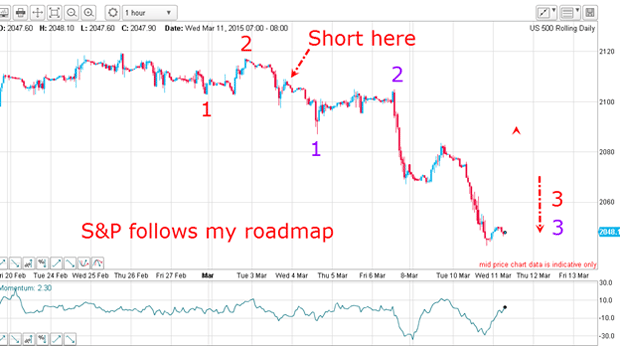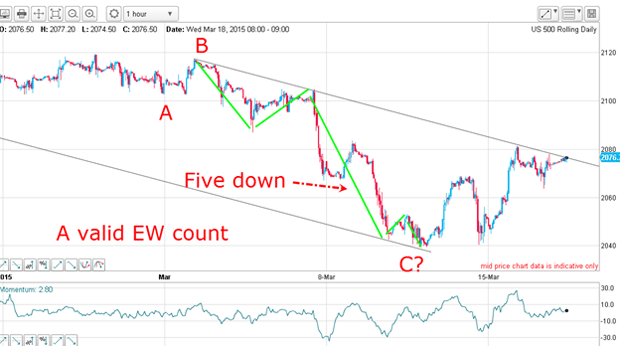If you want to be a good trader, don’t marry your trades
John C Burford uses the S&P 500 index to demonstrate why staying nimble is the key to trading success.
Before I start, I want to remind you that later today, the US Fed is expected to give a hint on when interest rates will start to rise. I expect volatility to be heightened.
That's that.
Today I want to show you why being nimble is a great trait for a swing trader.
Subscribe to MoneyWeek
Subscribe to MoneyWeek today and get your first six magazine issues absolutely FREE

Sign up to Money Morning
Don't miss the latest investment and personal finances news, market analysis, plus money-saving tips with our free twice-daily newsletter
Don't miss the latest investment and personal finances news, market analysis, plus money-saving tips with our free twice-daily newsletter
In my 11 March post,"My S&P trade keeps getting better", I explained why getting into a new trend early is essential for maximising profits on a swing trade.
This is what I wrote: "Getting in early gives you another valuable advantage:the trade risk is at its lowest near the top. That may sound counter-intuitive, but as the market declines off the top, you run the greater risk of running into some large rallies which can easily stop you out of a promising position too soon."
This means that traders need to keep a wary eye out for these large counter-trend rallies to extract maximum profits, In fact, you should do more than just keep an eye out; you must be prepared to exit at least part of your trade using my split-bet strategy, as outlined in my poston 13 March.
I called the S&P correctly, but my split bets protected me anyway

The market was making a series of 1-2s down a typical stair-step route to much lower prices but at the back of my mind was the possibility of one of those nasty rallies I mentioned. This was possible because the market was in major support territory put in from previous trading action.
Let's zoom out on that above chart so I can show you what I mean.
We can see that for the first five weeks of 2015, the market traced out a large congestion zone, where there was no clear direction with many up and down waves. This created a bank of disappointed shorts as the market broke out and moved higher into February.

When the market moved back down this month into the congestion zone, there were many relieved shorts who grabbed the chance to exit (by buying), thus supporting the rally.
With the market last Wednesday having deeply penetrated into this congestion zone, and with huge momentum divergences, the odds were stacked heavily in favour of a big rally. Such a rally would bring into question my bearish stance. This was the result:

Because a rally was now very much on the cards, it was prudent of me to take some of the big profits off the table; I used my split-bet strategy to come out 2,800 pips to the good.
Now, with profits in the bank, I was left with a part position, which I protected by moving my stop to break even. Even if the market soared back into the stratosphere, my shorting campaign would still leave me with a very good result.
A lesson learned: be flexible
Even though I was bearish last week, prudence dictated that I take some profits off the table. Not many traders can do that; some become married to their views and ride a big trade up before riding it all the way back down, and losing money.
Being prudent can be the most difficult thing to do the market is going nicely in your direction and you are naturally feeling good and confident in your analysis. The thought of taking some profits hardly crosses your mind but it should!
So, how does the market stack up this morning?
The move down can now be considered an A-B-C with its bullish implications. Wave C is in a five down, which is typical. This is the exact opposite of my roadmap last week!

Both scenarios are possible of course, but my original bearish count is less secure now, and that is why it pays to be nimble. If I had ignored the bullish implications, I would be still holding my entire original short trade and seeing my paper profits rapidly erode in the rally. That is not a happy place for a swing trader.
John is is a British-born lapsed PhD physicist, who previously worked for Nasa on the Mars exploration team. He is a former commodity trading advisor with the US Commodities Futures Trading Commission, and worked in a boutique futures house in California in the 1980s.
He was a partner in one of the first futures newsletter advisory services, based in Washington DC, specialising in pork bellies and currencies. John is primarily a chart-reading trader, having cut his trading teeth in the days before PCs.
As well as his work in the financial world, he has launched, run and sold several 'real' businesses producing 'real' products.
-
 Private school fees soar and VAT threat looms – what does it mean for you?
Private school fees soar and VAT threat looms – what does it mean for you?Rising private school fees could see more than one in five parents pull their children out of their current school. Before you remortgage, move house or look to grandparents for help, here’s what you need to know.
By Katie Williams Published
-
 Best and worst UK banks for online banking revealed
Best and worst UK banks for online banking revealedWhen it comes to keeping your money safe, not all banks are equal. We reveal the best and worst banks for online banking when it comes to protecting your money from scams
By Oojal Dhanjal Published